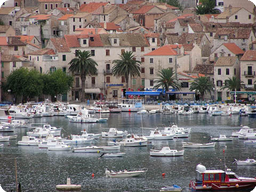

Komiža/island of Vis
Komiža/island of Vis  History of Komiža
History of Komiža
The town of Vis was founded in the 4th Century BC by Greek colonists from the island of Syracuse, and was the first Greek town on the eastern Adriatic coast. For the next four centuries, Polis Issa was indisputably the most powerful Adriatic city state. Because of the strategic significance of the island, throughout its sometimes turbulent history Vis experienced a fair number of changes in government, starting from the indigenous Illyrians to the Greeks, Romans, Italians, French, English, and in the last century, the Austrians. In spite of this unfavourable history, the people of Vis have managed to preserve their Croatian identity. In the town of Vis itself, remnants of the ancient Issa and a number of exhibits from the period are in safekeeping at the archaeological museum.
The first mention of the town of Komiža is found in a document dating back to the second half of the 12th century.
Komiža has always held to a strong fishing tradition, which can be seen today in its Fishermen's Museum, which is unique in Croatia. It's located in the historical Venetian tower along the sea front. Inside, you will find traditional fishing equipment. The replica of the traditional Komiža vessel, called gajeta falkuša, was exhibited at the 1998 World Fair in Lisbon, Portugal, as a symbol of Croatia’s nautical legacy.
Every year in Komiza, the 6th of December, the holiday of Saint Nicholas, the patron saint of travellers, sailors and fishermen, is also celebrated as the Day of the town of Komiža. A votive wooden boat is burned in front of the parish church.
The entire history of the island of Vis is politically and economically connected to the fishing industry on the one hand, and the cultivation of grapes and wine-making on the other. A combination of the traditional along with the increasing trend of tourism ensures a diverse and bright future for the island.
More than 2000 years have passed since the first praises were heard declaring the virtues of Vis' wines, and today, only a few people have not tasted or heard of the celebrated vugavu or plavac mali.
Source: http://www.tz-komiza.hr/hr/povijest.php
Source: http://www.vis-info.h
Video
Current news
 Macrocruise charter agency
Additional discount on the boat rental price of betw
Macrocruise charter agency
Additional discount on the boat rental price of betw


























